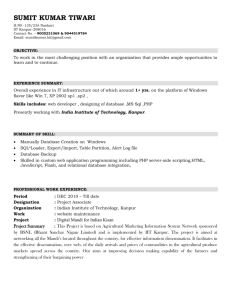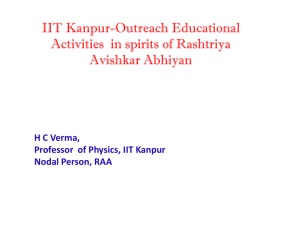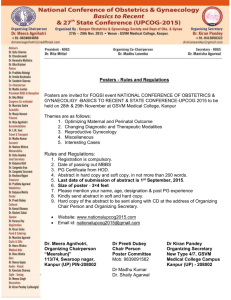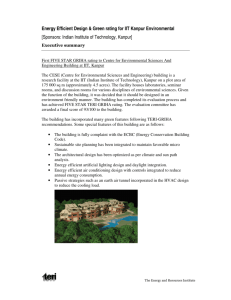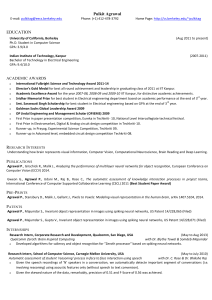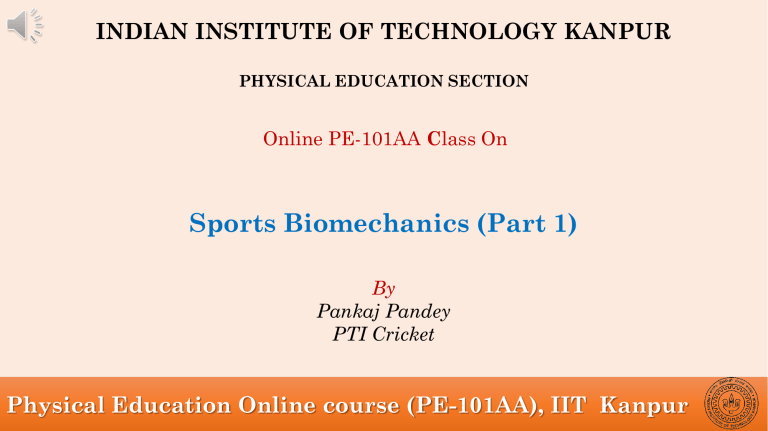
INDIAN INSTITUTE OF TECHNOLOGY KANPUR PHYSICAL EDUCATION SECTION Online PE-101AA Class On Sports Biomechanics (Part 1) By Pankaj Pandey PTI Cricket Physical Education Online course (PE-101AA), IIT Kanpur Concept of Biomechanics ➢ Meaning and Definition of the biomechanics ▪ Biomechanics is a combination of two words “BIO and MECHANICS”. Bio means life or living things and Mechanics refers to motion (The forces that acts on body). ▪ Biomechanics is the study of forces and their effect on living systems. ▪ The study of action of external and internal forces on living body specially on the skeletal system. ▪ External forces like friction, gravity, air etc. ▪ Internal forces like bones, muscles etc. Physical Education Online course (PE-101AA), IIT Kanpur Importance Of Biomechanics In Sports ➢1. Improvement of Sports Techniques ▪ Improvement of old techniques. ▪ Development of new techniques. ➢ 2. Improvement of Sports Equipment's /Facilities Personal equipment's like sports shoes, sportswear, guards. ▪ Technical equipment's like javelin, Pole, Racket, Bow & arrow, Ball etc. ▪ Sports facilities like artificial turfs, tracks, landing mattress etc. ▪ Instruments for measuring sports performance like electronic stopwatch, photo finish apparatus etc ➢ 3. Improvement of Sports Training ▪ Teaching correct movement pattern. ▪ Locating faults in execution. ▪ Identifying causes of faults. ▪ Suggesting appropriate corrections ▪ Standardizing exercises. ▪ Designing training equipment’s. ▪ Introducing new training methods. Cont. Physical Education Online course (PE-101AA), IIT Kanpur ➢4. Prevention of Sports Injuries • Techniques for preventing injuries. • Equipments for preventing injuries (Gloves, guards, mattress etc.) ➢5. Rehabilitation of Sports person • In designing the Rehabilitation Equipment as well as different types of orthotics, the knowledge of biomechanics comes very handy. Physical Education Online course (PE-101AA), IIT Kanpur Newton’s Law and Its Application in Sports ➢1.Law of Inertia ▪ It is first law of motion and according to this law, a body at rest will remain at rest and a body in motion will remain in motion at the same speed and in the same direction unless acted on by an external force. • A body will remain in its state of rest or motion unless some external force acts on it. Similarly, if an object is in a state of motion tries to remain in the same position, unless some external force is applied on, the tendency of bodies to resist a change in their state of motion is known as inertia. For example, a cricket ball will continue to be in motion until it is not stopped by resistance of rough ground and air. • Example :- A thrown ball will not go on forever in a straight line with uniform velocity, because of gravity and air resistance, two external forces that slow the ball and pull it downward. In the same manner a rolling ball will eventually come to rest because of frictional force, which always opposes the motion of one body over another. Physical Education Online course (PE-101AA), IIT Kanpur ➢ 2.Law of Acceleration • It is the second law of motion. According to this law, "A change in acceleration of an object is directly proportional to the force producing it and inversely proportional to its mass.” • Explanation :-This law indicates that a greater force is required to attain a certain space given time. If we fire a bullet on a window pane it will pass through the window pane and if we throw a big stone at this window pane, it will break the glass pane. The bullet has greater momentum than the stone, because it has greater speed. The second law of motion is applicable to relay races, while exchanging zone. • Application in Sports:- In cricket, while taking a high catch, the player is required to move -hands backwards while taking the catch. This increases the time, thus decreasing the force required to stop the ball. This ensures that the player doesn't get hurt in the process. Physical Education Online course (PE-101AA), IIT Kanpur ➢3.Law of Action & Reaction • According to this law, for every action, there is an equal and opposite reaction or for every action force there is an equal and opposite reaction force. • Explanation: - All forces act in pairs and one could say that for every force exerted by one body on another body, there is an equal and opposite force acting on the second body. Two forces must be interacted; for example when a sprinter drives against the start blocks, the blocks push back against his/her feet. Carrying this further, the blocks must in turn push against the ground which then instantly applies an opposite force against the blocks. If the blocks were to slip, there would be inadequate reaction and the runner would have a poor start. Other examples could be walking, jumping and so on. • Application in Sports :- In shooting, when a gun or pistol is fired the bullet moves forward(action). The gun or pistol jerks backward (reaction). When a person walks, he presses the ground in backward direction (action) by his feet. The ground pushes him in forward direction with an equal force (reaction). Physical Education Online course (PE-101AA), IIT Kanpur Levers, Type of Levers and Its Application in Sports ➢ Lever ▪ From the point of view of mechanics, a lever is a rigid bar , which can rotate about a fixed point when a force is applied to it to overcome a resistance. ▪ The proper use of levers plays an important role in sports for producing effective performances. Depending upon the requirements of the technique the different levers of the body (short, medium or long ) can be brought into action. Furthermore , many sports implements like hockey stick , golf club , cricket Bat and tennis rackets etc., in conjunction with the body segment, work as a part of the lever and work according to the principle of leverage. ➢ Type of Lever ▪ There are three types of levers and these are classified into three classes or orders, depending on the relative position of the fulcrum and the position where the force and the resistance act. Cont.. Physical Education Online course (PE-101AA), IIT Kanpur ➢ Lever of First order ▪ In the first order lever, the fulcrum lies in between the force and the resistance point. ▪ Examples :- Sea-saw, planter flexion, hyperextension of neck. ➢ Lever of Second order ▪ In a lever of the second order the resistance point lies between the fulcrum and the point of application of force. ▪ Examples :- opening of door, wheel barrow, the push-up and raising on the toe ➢ Lever of Third order ▪ In this class of lever, the point of application of force lies between the fulcrum and the resistance. ▪ Examples :- Elbow flexion , dorsiflexion , hitting a hockey ball, kicking a football Physical Education Online course (PE-101AA), IIT Kanpur Centre of Gravity and its Application in Sports ➢ Center of Gravity can be defined as “The single point at which all parts of an object are equally balanced. ➢ A persons center of gravity can change depending on their body position as the center of gravity is the exact point where all the parts of an object are equally balanced . Cont.. Physical Education Online course (PE-101AA), IIT Kanpur ➢The Center of gravity of the human body The point of exact center, around which the body may rotate freely in all directions • The point around which the weight is equal on all opposite sides or • The point of intersection of the three cardinal (primary) body planes sagittal frontal and horizontal. • ➢The following factors are important for understanding gravity and its effects on performance the center of • Because of the differences in the body structure between men and women, center of gravity is usually proportionately lower in women than in men. This gives women structural advantage in stability. • On the average center of gravity is proportionately higher in children than in adults as a result of the change in the body proportions as one progress from childhood to adulthood. • The center of gravity is effected by amputations and other structural changes which cause the body to deviate from normal. • Further, the addition of external weight. such as a backpack, will relocate the center of gravity. Physical Education Online course (PE-101AA), IIT Kanpur Line of gravity ➢Line of Gravity is the vertical line that passes through the center of gravity to the ground. ➢If the line of gravity falls within the objects base of support (i.e. Its contact with the ground), the object is relatively stable. ➢If the line of gravity falls outside the object’s base of support (i.e. its contact with the ground), the object is relatively unstable. Base of Support(BOS)) Physical Education Online course (PE-101AA), IIT Kanpur Force ➢A push or a pull on an object that can cause it to change direction is termed as Force. Force only exists as a result of an interaction. ➢Force is the effect that one body has on another body. ➢we cannot observe the force but we can only perceive its effect. for example when a force is applied on a football, we can not observe the kicking force but we can observe the effect of the force on the ball i.e. the motion in the football. ➢Example: When we push to open the door, swimming in the water to move , throwing a ball, kicking a football, lifting a weight, we apply force on it. Physical Education Online course (PE-101AA), IIT Kanpur The Production of force ➢External forces are produced from outside the body & originate from gravity, inertia, or direct contact. ➢Only muscles can actively generate internal force, but tension in tendons, connective tissues, ligaments, and joints capsules may generate passive internal forces. ➢The appropriate sequence to get maximum force is necessary. Physical Education Online course (PE-101AA), IIT Kanpur Application of Force ➢The force on an object must be applied in the direction in which it has to travel. ➢All activities require a summation of forces from the beginning of movement in the lower segment of the body to the twisting of the trunk and movement at the shoulder, elbow, and wrist joints. Absorption of Force ➢Significant mechanical loads are generated & absorbed by the tissues of the body. ➢Tension in tendons, connective tissues, ligaments, and joints capsules may generate passive internal forces. Physical Education Online course (PE-101AA), IIT Kanpur INDIAN INSTITUTE OF TECHNOLOGY KANPUR PHYSICAL EDUCATION SECTION Online PE-101AA Class On Sports Biomechanics (Part 2) By Pankaj Pandey PTI Cricket Physical Education Online course (PE-101AA), IIT Kanpur Centripetal Force ➢A force which acts on a body moving in a circular path and is directed towards the centre around which the body is moving. ➢Centripetal force: this is the force that pushes or pulls an object towards the axis of rotation in order to make it follow a curve or circular pathway. When a player swings a bat, he applies centripetal force to make that bat follow the arc of swing. ➢Centripetal force is needed by the player to maintain his grip. If the rotational momentum is more, the centrifugal force could cause the player to lose his grip and the bat may go of the hand. ➢These forces act when a runner takes a sharp bend leans inward to obtain the necessary centripetal force. ➢A cyclist going round the curve leans towards the centre of the curve in order to get necessary centripetal force. Physical Education Online course (PE-101AA), IIT Kanpur Centrifugal Force ➢Centrifugal force • This is the force that pushes or pulls an object outward from the axis of rotation. This force is equal and opposite of the centripetal force. • A good example of centrifugal force is something you can try for yourself. Stand, with your arms relaxed, at your sides. Then spin round slowly, gradually increasing your speed. If you’re relaxed, you should feel your arms and hands gradually floating outwards - it feels as if some force is pulling them outwards. That’s centrifugal force. Now, while you’re spinning at top speed, loosely bring your right arm and hand inwards, towards your body. If you do this correctly, you will feel a force making your hand veer away, at right angles to your body and to the inward movement of your arm. Physical Education Online course (PE-101AA), IIT Kanpur Projectile Trajectory and Factors Affecting Projectile Trajectory ➢Projectile • A projectile is a body or object that is in the air and is under influence of the forces of gravity and air resistance • Object thrown into the air horizontally or at an acute angle under the action of gravity is called projectile. ➢Trajectory ▪ It is the path of a projectile or other moving body through space (air). ▪ The path followed by a projectile is called its trajectory and it is a parabolic path. ▪ A foot ball trajectory in the air. Physical Education Online course (PE-101AA), IIT Kanpur Factors Affecting Projectile Trajectory • Initial velocity • Angle of projection • Projection height • Air resistant • Gravity • Spin Cont.. Physical Education Online course (PE-101AA), IIT Kanpur ➢Projection height (height of release) : The higher the level of release the longer distance is cover in flight ➢Air resistance : When a projectile moves through the air it is slowed down by air resistance ➢Gravity : Gravitational force is exerted by earth on all the objects. ➢Spin : Amount and direction of spin directly affects the distance covered. Physical Education Online course (PE-101AA), IIT Kanpur Motion ➢ Motion may be define as an act or process of changing place or position relative to some point of reference or in other word the locomotion of a body mass in space in time. Forms of Motion ➢ A. Geometrical Course of Motion ➢ Linear Motion ▪ All parts of the body move in the same distance at same time and in the same direction . Ex. 100 meter sprint, punching in boxing. Physical Education Online course (PE-101AA), IIT Kanpur ➢Angular Motion ▪ A body moves along a circular path about an imaginary line. Example : Knee Flexion, rotation on the horizontal bar. ➢General Motion ▪ Combination of the linear and angular motion. Example : A football traveling in air with rotating on its own axis Physical Education Online course (PE-101AA), IIT Kanpur ➢ B. Chronological Course of Motion ➢Regular motion ▪ Equal distances covered in equal intervals time ➢Non regular motion ▪ Unequal distances covered in equal intervals time Physical Education Online course (PE-101AA), IIT Kanpur Work Power Energy ➢ Work ▪ Work W= F X S ▪ Work done = constant force X Distance (moved in the direction of the force) ▪ The work done during a lift is equal to the work done to lift the bar plus the work done to lift the body if we assume that the bar and center of mass of the lifter moved 40cm (0.4 meter) and that the average force measured via a force platform was 800 N than we can calculate the work done: W=FxD =800Nx0.4M = 320NM =320 J ➢ Power The rate of doing work or rate of using energy. Power = work done time taken to do work Physical Education Online course (PE-101AA), IIT Kanpur ➢ Energy • The energy is the capacity to do work • Kinetic energy = ½ mv2 joule • Potential energy=mgh joule Physical Education Online course (PE-101AA), IIT Kanpur Friction ➢Meaning of friction ▪ Friction is the force resisting the relative motion of solid surface, fluid layers and material elements sliding against each other. It creates obstruction to moving objects. Friction is a force that is created whenever two surfaces move or try to move across each other. Friction always opposes the motion or attempted motion of one surface across another surface. Friction is dependent on the texture of both surfaces. Friction is also dependent on the amount of contact force pushing the two surfaces together. There are several types of friction : Static friction, dynamic friction, fluid friction, dry friction, sliding friction, rolling friction, internal friction etc. ➢Definition of Friction ▪ “Friction is the rubbing of an object or surface against another.” ▪ “Friction is the resistance that one surface on object encounters when moving over another.” Cont.. Physical Education Online course (PE-101AA), IIT Kanpur ➢Types of friction : ▪ (i) Static Friction (ii) Kinetic Friction ▪ Static Friction : The opposing force that comes into play when one body tends to move over the surface of another, but the actual motion has not yet started, is called static friction. ▪ Kinetic Friction : Kinetic friction is the friction between objects in motion. The surface of the object producing friction should be dry. It is a product of the coefficient of kinetic friction and the normal reaction force. It occurs when two surfaces are in motion relative to each other. Physical Education Online course (PE-101AA), IIT Kanpur ➢ Advantages of Friction • Friction between pen and paper enables us to write on the paper. • Friction between our feet and the ground allows our movements like standing, walking and running. • Friction between the surface of the road and tyres of our vehicles allow the vehicles to move without slipping. Physical Education Online course (PE-101AA), IIT Kanpur ➢ Disadvantages of Friction • Friction causes moving objects to stop or slow down. • Friction produces heat causing wastage of energy in machines. • Friction causes wear and tear of moving parts of machinery, soles of shoes, etc. Physical Education Online course (PE-101AA), IIT Kanpur References ➢Fundamental of Bio-mechanics by Duane Knudson ➢Mechanical Aspects of Human Motion by Ramesh Rai ➢Kinesiology and Biomechanics by Dr. A.K.Uppal & Jogiswar Goswami ➢Sports Biomechanics.by Anthony Blazevich ➢Health and Physical Education Text Book by Dr. V.K.Sharma ➢Web sources (Images) Physical Education Online course (PE-101AA), IIT Kanpur Thank You Physical Education Online course (PE-101AA), IIT Kanpur INDIAN INSTITUTE OF TECHNOLOGY KANPUR PHYSICAL EDUCATION SECTION Online PE Class On Kinesiology (Part 1) By Pankaj Pandey PTI (Cricket) Physical Education Online course (PE-101AA), IIT Kanpur Concept of Kinesiology ➢ Meaning and Definition Of Kinesiology ➢ Kinesiology is a consist of two Greek word kinesis and logia, kinesis means motion (movement) and logia means ‘to study 'or discourse. Thus kinesiology means the study of motion.(science of movement). ➢ Kinesiology is the study of the principles of mechanics and anatomy in relations to human body. ➢ Kinesiology – anatomy + mechanics Physical Education Online course (PE-101AA), IIT Kanpur Importance/ Role of Kinesiology ➢I. Role of kinesiology in coaching. • By the help of it a coach can analysis the performance smoothly and strictly in accordance with the principle of mechanics. ➢II. Role of kinesiology in physical fitness program. ▪ An athlete with poor physical fitness requires a systematic exercise program for development of his physique. ▪ Exp- A swimmer may require exercise(systematic) for development of range of movement of his shoulder joints. ▪ A long jumper also require a good explosive strength.. ▪ A gymnast require exercise for the development of upper body. ➢III. Role of kinesiology in scientific weight training. • A coach must know the location and action or movement of the muscles and then only should decide the weight training program. cont.. Physical Education Online course (PE-101AA), IIT Kanpur ➢IV. Role of kinesiology assessing kinesiological aptitude of performance. • If short heighted-[gymnastics, weight lifting, wrestling] If long heighted-[volleyball, basketball, high jump] ➢ V. Role of kinesiology for preventing injuries. • Design the training program according injury less movements ➢VI. Role of kinesiology adjusting implement ground and other factors. equipment, clothing, apparatus • Like in sprinting event which type of start will be comfortable or block and which type of clothes will be comfortable etc. ➢VII. Scientific analysis of skill. -Rectification of the faults. ➢VIII. Selection of proper conditioning exercise. • Which type of conditioning exercise will be good during competition period and transitional period and which type of movement is good or injuries less. ➢IX. Modification of technique.-Like- straddle and Fosbury techniques in high jumps. Physical Education Online course (PE-101AA), IIT Kanpur Terminology Of The Fundamental Movement ➢Flexion - Flexion is a movement which decreases the angle at the moving joints. Exp. flexion of the elbow, flexion of the knee. ➢Extension - Extension is the opposite movement of flexion which increases the angle of joints. Exp. extension of the elbow, extension of the knee. ➢Abduction - When any part of body is moved sideward and away from the mid-line of the body, the movement is termed as abduction . Exp. sideward elevation of the arm, sideward elevation of the leg. ➢Adduction - When the body part which is abducted is moved towards the midline of the body, the movement is termed as adduction. Exp. adduction of the arm. Cont.. Physical Education Online course (PE-101AA), IIT Kanpur ➢Supination - Supination is rotational or turning movement with respect to the midline of the body or the body segment which is done outward. Exp. outward rotation of the arm. ➢Pronation - Pronation is also a rotation or turning movement with respect to the midline of the body segment but it is done inward. Exp. inward rotation of the arm ➢Planter flexion - When the toe going away from the tibia the movement termed as plantarflexion. Exp. Toe stretch in gymnastics. ➢Dorsi flexion - When the toe coming close to the tibia the movement termed as dorsiflexion. Exp. Dorsiflexion at the ankle joints. Cont.… Physical Education Online course (PE-101AA), IIT Kanpur ➢Rotation - When the body segment or the whole body turns or twist around its midline the movement termed as rotation. Rotation may be from left or right(clockwise or anti-clockwise) Exp. Inward or outward rotation of the leg. ➢Circumduction - These movement may take place obliquely to the three planes and axes and generally occurs in circular manner these movement termed as circumduction's. Exp. Circumduction of the finger and shoulder Cont.. Physical Education Online course (PE-101AA), IIT Kanpur ➢Inversion - When the sole of the foot faces inward that is towards the midline of the body, the movement termed as inversion. This movement is only countable at the ankle joint. Exp. Walking on the outside of the foot. ➢Eversion - When sole of the foot faces outward, the termed as eversion. This movement is also countable only at ankle joint. Exp. Walking on the inner side of the foot. Physical Education Online course (PE-101AA), IIT Kanpur INDIAN INSTITUTE OF TECHNOLOGY KANPUR PHYSICAL EDUCATION SECTION Online Class On Kinesiology (Part 2) By Pankaj Pandey PTI (Cricket) Physical Education Online course (PE-101AA), IIT Kanpur Fundamental concept of Axis and Planes ➢Axis ▪ Axis means an imaginary line which through a body, around which movement takes place. ▪ Any rotatory movement of a body or its segments take place around an imaginary line which is termed as an axis. ▪ The best natural example is the imaginary axis of the earth which passes through the north and the south pole and around which rotation of the earth take place. ▪ There are three traditional axis which are perpendicular to each other. ▪ There are also three traditional cardinal plane which are perpendicular to each other. Physical Education Online course (PE-101AA), IIT Kanpur ➢ Frontal Axis-Frontal axis is an imaginary line which passes through a body horizontal from side to side. ➢ Sagittal Axis-Sagittal axis is an imaginary line which passes through a body horizontal from front to back. ➢ Vertical Axis-Vertical axis is an imaginary line which passes through a body vertically and perpendicularly downward. ➢Plane ▪ Plane is an imaginary surface which passes through a body and in which movements takes place. Plane is two dimensional surface which divide the body into two equal half of same mass. ▪ Any movement of the body or its segments around an axis can be justified to be a movement in an imaginary surface which is termed as a plane. ▪ The three cardinal planes are as follow. ➢ Frontal plane – Frontal plane is an imaginary surface which passes through the body from side to side and divides the body in to two equal front and back halves of same mass. ➢ Sagittal Plane – Sagittal plane is an imaginary surface which passes through the body from front to back and divides the body in to two equal left and right halves of same mass. ➢ Horizontal Plane - Horizontal plane is an imaginary surface which passes through the body horizontally and divides the body in to two equal top and bottom halves of same mass. Physical Education Online course (PE-101AA), IIT Kanpur Relationship Between The Three Axis and Plane ➢ All the three axis are perpendicular to each other. ➢ All the three planes are perpendicular to each other. ➢ Frontal axis acts perpendicular on sagittal plane. Any movement in the sagittal plane will be around the frontal axis. ➢ Sagittal axis acts perpendicular on frontal plane. Any movement in the frontal plane will be around the sagittal axis. ➢ Vertical axis acts perpendicular on horizontal plane. Any movement in the horizontal plane will be around the vertical axis. ➢ Frontal axis acts parallelly to the frontal plane. ➢ Sagittal axis acts parallelly to the sagittal plane. ➢ Vertical axis acts parallelly to the frontal and sagittal plane. ➢ Horizontal plane acts parallelly to the frontal and sagittal axis. Physical Education Online course (PE-101AA), IIT Kanpur Movements with relation to axis and planes ➢ Frontal axis and sagittal plane a) b) c) d) Flexion Extension Dorsi flexion Planter flexion ➢ Sagittal axis and frontal plane a) b) c) d) Abduction Adduction Eversion Inversion ➢ Vertical axis and horizontal plane a) b) c) d) Inward rotation of leg. Outward rotation of leg. Pronation of arm. Supination of arm. Physical Education Online course (PE-101AA), IIT Kanpur Mechanical Analysis of Walking and Running ➢ Difference between walking and running. ➢ Running • • • • Running is a process, in which both feet's are off the ground in the float phase. There is a double swing phase and the swing phase is longer. Linear and Angular velocity of lower limbs is faster. Running requires greater range of motion. ➢ Walking • • • • Walking is a process , in which at least one part of body (foot) remains in contact with the ground. There is a longer stance phase where as swing phase is shorter. The linear and angular velocity of lower limbs is slower. Walking requires lesser range of motion. Physical Education Online course (PE-101AA), IIT Kanpur Mechanical analysis of walking Stance phase ➢ ➢ ➢ ➢ ➢ Heel strike Early flat foot Late flat foot Heel rise Toe off Physical Education Online course (PE-101AA), IIT Kanpur ➢ Swing phase ▪ Initial swing ▪ Mid swing ▪ Terminal swing ➢ Mechanical Analysis of Running Stance Phase ▪ ▪ ▪ Initial contact Absorption Mid-stance Swing phase ▪ ▪ ▪ Initial swing Mid swing Terminal Physical Education Online course (PE-101AA), IIT Kanpur References ➢Kinesiology and Biomechanics by Dr. A.K.Uppal & Jogiswar Goswami ➢Health and Physical Education Text Book by Dr. V.K.Sharma ➢NSNIS Patiala Kinesiology. ➢Google Primary Search (Images)/web resources Physical Education Online course (PE-101AA), IIT Kanpur Thank you Physical Education Online course (PE-101AA), IIT Kanpur
